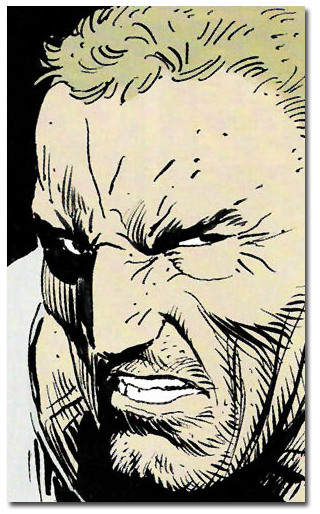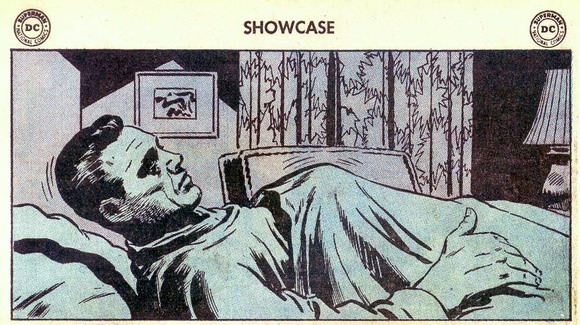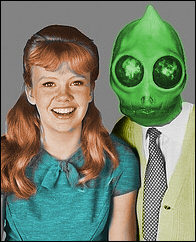Like many stores, the one I work at has a community bulletin board and free give away pamphlets, ad-driven magazines and brochures. One pamphlet in particular pictured here gives advice to family members and aging drivers about when it may be time to turn over the keys to someone else. Yeah, I got some advice...
Yeah, I got some advice...
Thursday, March 30, 2006
Grocery Store Artifact & PSA: Aging Driver Pamphlet
Posted by
Sleestak
at
3/30/2006 04:58:00 PM
0
comments
![]()
![]()
Wednesday, March 29, 2006
PS Magazine March 2006: Joe Kubert goes invisible
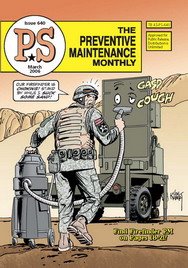 Some good images from Joe Kubert in this month's PS Magazine!
Some good images from Joe Kubert in this month's PS Magazine!
Pluses in this issue:
* Cyborg war machines looking for love in all the wrong places.
* Bear!
* How to clean sand out of your crevices.
* Haz Mat PSA's.
* Good battery care.
* Invisible. Freaking. Soldiers.
* No puppies killed.
There is a problem supplying armor?
Oh noes! No death from above today!
Sir! I wish i could quit you! Sir!
I yam what I yam!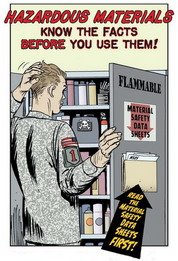
Mmm...polyethyl benzenes!
A soldier in this story learns to his eternal regret that shirking maintenance on your invisibility suit to play the Fantastic Four video game could have fatal consequences. As if any military would allow grunts to do preventive maintenance on a multi-million dollar invisibility suit.
Good to see that the demon bear from New Mutants finally got another gig.
Enjoy!
Posted by
Sleestak
at
3/29/2006 04:59:00 AM
0
comments
![]()
![]()
Tuesday, March 28, 2006
Attack of the Fluffy Bunnies
Postmodernbarney shows us the face of evil in the form of a cartoon mascot for snacks.
While frightening, Dorian's example is of a stealth-horror. He gives us the psycho...The homicidal maniac who on the surface looks like any other rabbit until it tears off your skin and eats it while whipping skippy in a frenzy with the Sound of Music soundtrack playing on the stereo in the background.
Yet, I find this image of a local Maryland corporate logo far more disturbing. The happy, scythe-wielding bunny I saw on the side of a delivery truck a few years ago is truly terrifying, but in a manner different than the serial killer offered by the postmodernbarney-meister.
The happy, scythe-wielding bunny I saw on the side of a delivery truck a few years ago is truly terrifying, but in a manner different than the serial killer offered by the postmodernbarney-meister.
There is something about a cutesy, funny-animal grim reaper gleefully lopping off the heads of the partially entombed-alive victims that makes me lock the doors and keep the lights on at night. The bunny's name? I bet it's Jason.
Tags: Maryland Sucks
Posted by
Sleestak
at
3/28/2006 02:37:00 AM
0
comments
![]()
![]()
Monday, March 27, 2006
More Money-Saving Comic Covers: First Flight
 In 1987 the talented artist Luis Royo supplied this wrap around cover art for Chris Claremont's verbose alien contact science fiction novel First Flight.
In 1987 the talented artist Luis Royo supplied this wrap around cover art for Chris Claremont's verbose alien contact science fiction novel First Flight.
Yes, I bought it when it first came out only because it was by the writer of the X-Men. Yes, I was dissapointed in it because the novel had as protagonists characters clearly inspired by the X-Men's Storm and Wolverine. The asian, male fight-master mentor of the female lead actually had his genetic structure modified by the alien visitors to make him more cat-like and feral.
Chris...Chris...Chris. Tsk.
Then a few years later the same art showed up as a cover for issue #37 of the Italian comic series Lanciostory Anno VXII (October 1991).
It isn't exactly accurate to state that the comic cover is 'money-saving', unless the rights-holder gave the publisher a discount for recycling old art. If nothing else, it would be more precise to say that the art was 'time-saving', instead. It seems pretty clear that Royo (or whoever owns the art) sold the use of the image to the fumetti publisher to use for Lanciostory. While the comics fan in me dislikes seeing recycled images and prefers new stuff AT ALL TIMES, there is  nothing at all wrong with it. An artist can sell his portfolio wherever and whenever he wants.
nothing at all wrong with it. An artist can sell his portfolio wherever and whenever he wants.
As you can see from using the GCD link above, Lanciostory used painted covers for all their magazines. I recognized only two covers has having been used elsewhere. If there are more that have similar provenance I do not recognize them, though a few seem to have familiar layouts. Issue #37 was not the only time they used recycled art. One is from First Flight and the other used art was previously published as the cover for the 1985 Ace edition of Probe, by Carole Nelson Douglas, which later then graced the cover of Lanciostory #47 (1991).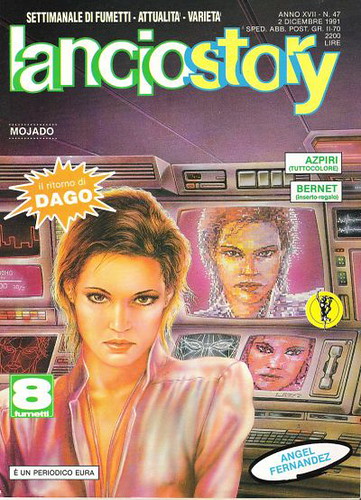 Previous frugal covers: On The Spot and Dell's monster anthology.
Previous frugal covers: On The Spot and Dell's monster anthology.
Posted by
Sleestak
at
3/27/2006 07:22:00 PM
0
comments
![]()
![]()
Saturday, March 25, 2006
Joe Kubert Hates Puppies
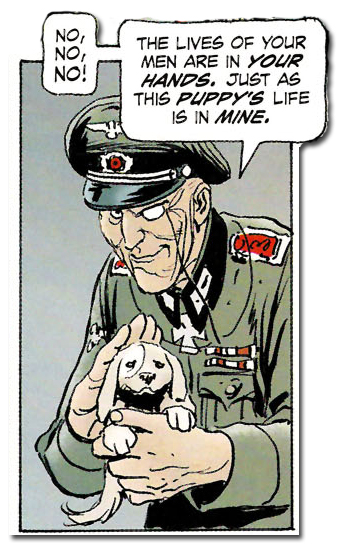 Uh-oh! A Nazi gets hold of Easy Company's puppy in the recent Sgt. Rock: The Prophecy #3!
Uh-oh! A Nazi gets hold of Easy Company's puppy in the recent Sgt. Rock: The Prophecy #3!
While I really like the Sgt. Rock mini, I have been less intrigued by the over all story than I am in finding out exactly when the pup (named Pup, by the way) gets sent to doggie-hell via the Kubert Express.
Probably the best indicator that you are destined for a messy end in popular media is to be an ensign wearing a red shirt in Star Trek, Kyle Raynor's girlfriend or a puppy in a comic book featuring the talents of Joe Kubert.
Of late the comic blog-o-sphere has been on fire with speculation as to the ultimate fate of the orphan pup adopted by Easy Company's great big racist soldier known as Bull. Interestingly, the issue is perhaps purposely vague as to what actually happened to the cute little mutt. After all, as Marv Wolfman once asserted, "If you do not personally see a body then they are not dead."
I have so many questions: Is the puppy only wounded? Did the puppy get hurt at all or was he just surprised? Is it...dead? Oh, Joe, you cruel bastard. How can you make us wait until issue #4 comes out to get the full details? I refuse to believe that a puppy in a Joe Kubert opus only gets assigned one measly panel in which to portray it's fate. I think there is some sort of comic book law that requires any Kubertesque dog to get at least 2 pages to show it's death, not counting the obligatory heart-breaking doggie-grave site scene.
A clue as to what ultimately happened to Pup might be seen in Sgt. Rock's face.
Another puppy-fate clue is comic history. Joe Kubert is known to be pretty hard on the cute little puppies. For Star Spangled War Stories #148 (Dec 1970), Joe and Robert Kahniger once conspired together to drop a wounded puppy from the open cockpit of a World War I fighter plane piloted by the Enemy Ace for no reason!
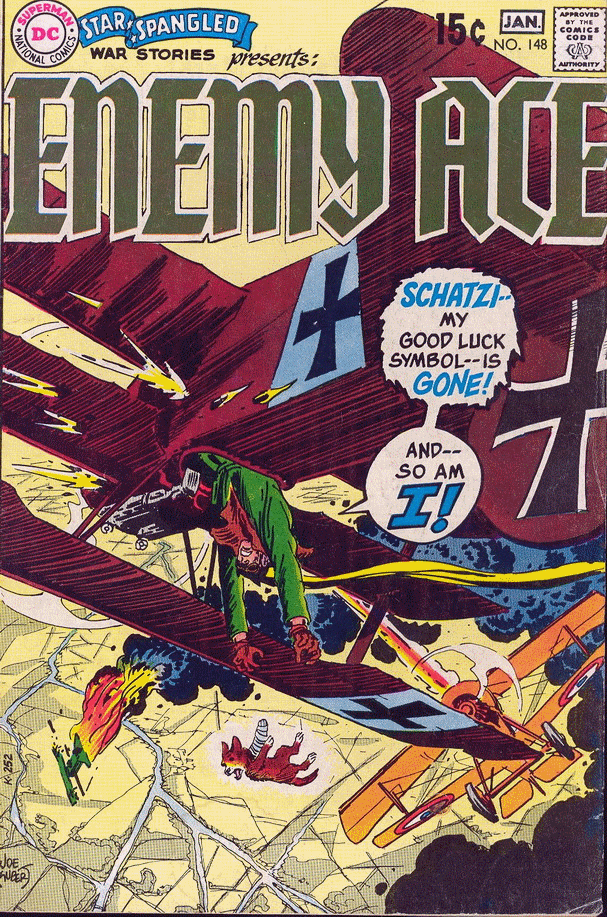 As proof of Kubert's dog-hate check this related post from the caveman days of my blog: Luck Is A Puppy Named ..Oops!.
As proof of Kubert's dog-hate check this related post from the caveman days of my blog: Luck Is A Puppy Named ..Oops!.Give me some closure, Joe!
Posted by
Sleestak
at
3/25/2006 05:47:00 PM
2
comments
![]()
![]()
Friday, March 24, 2006
Comic Book Ad: Super-Patriot or Super-Hippie?
 Peace, man!
Peace, man!
From Superman #246 (v1, Dec 1971)
Posted by
Sleestak
at
3/24/2006 06:51:00 PM
5
comments
![]()
![]()
Thursday, March 23, 2006
What if the real world was more like comic books?
 Okay, this news article about the FBI dropping the ball before 9/11 irks me so much I may vote in the next elections just to help kick out of office every bonehead who was a part of the rampant culture of incompetence that existed. Oh, some people were not directly associated with the system that allowed such a failure? Too bad, bunkie. You were an active part of the system as a whole and you didn't fix it. You had your chance. Maybe the next guy won't sit on his thumbs. I'm a firm believer that any large industrialized country, for example: America, has the resources to fix their problems (like porous borders) if they really want to. If they don't, then someone is taking steps to ensure that a given situation stays a problem. The only reason why any country allows billions per year in insurance fraud is because someone is getting rich off it. No business that allows such money to be falsely claimed stays solvent unless someone on the back end is getting wealthy by allowing it to happen.
Okay, this news article about the FBI dropping the ball before 9/11 irks me so much I may vote in the next elections just to help kick out of office every bonehead who was a part of the rampant culture of incompetence that existed. Oh, some people were not directly associated with the system that allowed such a failure? Too bad, bunkie. You were an active part of the system as a whole and you didn't fix it. You had your chance. Maybe the next guy won't sit on his thumbs. I'm a firm believer that any large industrialized country, for example: America, has the resources to fix their problems (like porous borders) if they really want to. If they don't, then someone is taking steps to ensure that a given situation stays a problem. The only reason why any country allows billions per year in insurance fraud is because someone is getting rich off it. No business that allows such money to be falsely claimed stays solvent unless someone on the back end is getting wealthy by allowing it to happen.
Harry Samit, the FBI agent who arrested Moussaoui three weeks before the deadly airliner hijackings that killed 3,000 people, testified on Monday that agency superiors repeatedly blocked his efforts to warn of a possible terror attack.As any reader of comic books knows, the lower-echelon grunts in the field are always correct in their suspicions and warnings of disaster. If the Pentagon librarian claims that Dr. Doom is going to sink Manhattan, then the brass better heed the words and call the Super-Buddies in to handle it. This type of anti-hero oracle is a tradition going back hundreds of years that popular media, including comic books, has continued to use and makes use of more often than I'd like. It's an easy, somewhat cliched plot device that creates conflict and suspense while moving the story forwards, even if it is in a predictable manner.
Die Hard, 24, Silkwood, the Bible and Jor-El's warnings to the science council in Superman's origin all utilized the story device. I doubt that there is any fictional series in existence that hasn't used the "I Told You So" premise somewhere in it's run. It even showed up in Star Trek: Voyager once. The cyborg Seven of Nine was convinced that there was a massive conspiracy of malfeasence on the part of the government. It was revealed that the seemingly related events turned out to be innocent and unconnected, because her initial theory was based on a fallacy. Inverting the plot device had the effect of making the whistle-blower appear unbalanced.
The reason it is used so much is that the basic conflict between subordinate and superior allows for drama. The observer is part-conspirator and is made to feel they are in on the secret. It also lets the reader or viewer identify with the character as an outsider...a rebel...even though the character may be an authority figure.
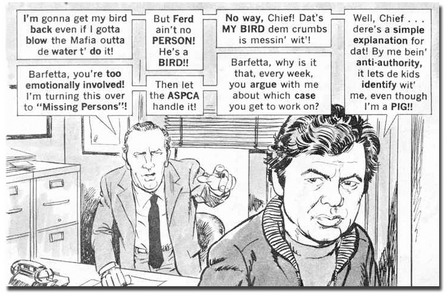 "Barfetta" MAD Magazine #183 (June 1976)
"Barfetta" MAD Magazine #183 (June 1976)"Sir, maybe you shouldn't release Etrigan from the binding spells to talk to him..."Alien Legion #5 (v1, Dec 1984) is a good example of just this sort of story device.
"Silence, Lackey! Now, demon. Since I have just freed you I demand you answer my quest - AAAAARRGH!" (This actually happened in the Byrne series Blood of the Demon)
"Ok. On my order, wake up the Hulk with electric shocks to his testicles and focused gamma rays to the aggression-centers of his brain."
"Uhhh, maybe we shouldn't, Ma'am."
"Just do it! I'm in charge here!"
"HULK SMASH!"
"Mr. Guardian...Sir? Hal's acting kind of...odd... lately"
"Riiiiiiight. Begone, short-lived one!"
 Of course, in popular entertainment the protagonist always disobeys orders and after being hunted and branded a traitor for a few issues/chapters/hours manages to cut the blue wire just as the timer reaches zero to save the day.
Of course, in popular entertainment the protagonist always disobeys orders and after being hunted and branded a traitor for a few issues/chapters/hours manages to cut the blue wire just as the timer reaches zero to save the day.Yet the FBI agent's testimony makes me wonder...What If?
What if Agent Samit leaked the memo to the press?
What if his superior did a better job?
What if the agent jumped the chain of command and yelled until someone listened?
What if the real world was more like comic books?
Posted by
Sleestak
at
3/23/2006 07:32:00 PM
0
comments
![]()
![]()
Tuesday, March 21, 2006
Give us Ultimate Mxyzptlk
 While DC is rebooting (sorta) the DC Universe from the events in Infinite Crisis, I would like a return of one of the best portrayals of that 5th dimensional imp, Mxyzptlk, to the new DCU. While I liked the version as penned by Alan Moore in Whatever Happened To The Man Of Tomorrow? (that of a bored amoral extra-dimensional sorcerer), I really appreciated the Steve Gerber depictions of Dark Mxy. That guy was scary on so many levels. Gerber-Mxy was the type of guy who would turn your lungs into a yummy dessert treat just to watch you cough up Vanilla-Chocolate Swirls pudding. It isn't too much of a stretch to bring in the Gerber version from a vanished reality into the mainstream DCU, since they already paved the way with World's Funnest and Power Girl.
While DC is rebooting (sorta) the DC Universe from the events in Infinite Crisis, I would like a return of one of the best portrayals of that 5th dimensional imp, Mxyzptlk, to the new DCU. While I liked the version as penned by Alan Moore in Whatever Happened To The Man Of Tomorrow? (that of a bored amoral extra-dimensional sorcerer), I really appreciated the Steve Gerber depictions of Dark Mxy. That guy was scary on so many levels. Gerber-Mxy was the type of guy who would turn your lungs into a yummy dessert treat just to watch you cough up Vanilla-Chocolate Swirls pudding. It isn't too much of a stretch to bring in the Gerber version from a vanished reality into the mainstream DCU, since they already paved the way with World's Funnest and Power Girl.
Steve Gerber wrote (in what one could call a "Marvelization" of DC) one of the better Pre-Crisis stories of the Superman mythos in the 1982 Phantom Zone mini-series. Basically, the mini was the Superman 2 movie done right. In that 4-issue run drawn by Comic Art God Gene Colan, while battling escaped PZ villains Superman learns that the Phantom Zone is not what he believed it was. What Superman assumed was a harmless limbo dimension that served as a "humane" prison first discovered by Kryptonians was actually a defensive barrier generated around an other-dimensional xenophobic entity named Aethyr.
Phantom Zone mini-series. Basically, the mini was the Superman 2 movie done right. In that 4-issue run drawn by Comic Art God Gene Colan, while battling escaped PZ villains Superman learns that the Phantom Zone is not what he believed it was. What Superman assumed was a harmless limbo dimension that served as a "humane" prison first discovered by Kryptonians was actually a defensive barrier generated around an other-dimensional xenophobic entity named Aethyr.
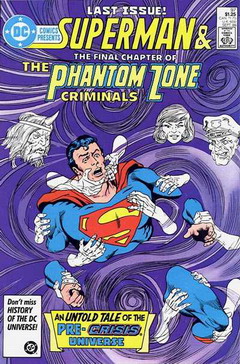 Four years later it's Post-Crisis in the DCU, and in a Pre-Crisis story about the Zone prisoners, Steve Gerber and Rick Vietch revisit the concepts of the mini in the 1986 DC Comics Presents #97. This issue is horrifying and cruel in content. The Zone villains escape when Aethyr is manipulated by a Kryptonian magician and they attack Earth with a viciousness that rivals the destruction seen later in Byrne's Superman run, when the pocket-universe Kryptonians commit genocide. In this story Mxyzptlk merges with Aethyr as a way to escape his own prison and goes right around the bend.
Four years later it's Post-Crisis in the DCU, and in a Pre-Crisis story about the Zone prisoners, Steve Gerber and Rick Vietch revisit the concepts of the mini in the 1986 DC Comics Presents #97. This issue is horrifying and cruel in content. The Zone villains escape when Aethyr is manipulated by a Kryptonian magician and they attack Earth with a viciousness that rivals the destruction seen later in Byrne's Superman run, when the pocket-universe Kryptonians commit genocide. In this story Mxyzptlk merges with Aethyr as a way to escape his own prison and goes right around the bend.His first act is to "tease" Superman by transporting the star-lost ghost-city of Argo to Earth directly over Metropolis...And then lets it fall. Superman smashes the asteroid even as he succumbs to radiation poisoning, scattering tons of Kryptonite and radioactive corpses over the entire cityscape. Since it's Mxy, Superman probably thinks he is just dealing with an unusually cruel prank that will magically repair itself once the imp leaves for other parts. Not this time.
The Mxy and Aethyr entity are insane. Rampant xenophobia, frustration and unlimited power makes for a wicked and unstable combo. After Superman heals a bit he gets into final battle with the escaped Zone villains. During the fight Superman is surprised when Mxy/Aethyr aids him by absorbing the villains into his consciousness not out of altruism, but to personally torture them just for kicks.

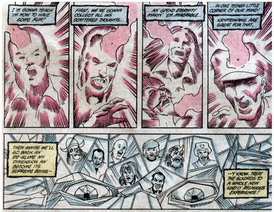 Interestingly, something similar also happened in Gerber's back-up story in the Bloodstone finale written years prior in Marvel's 1978 Rampaging Hulk magazine.
Interestingly, something similar also happened in Gerber's back-up story in the Bloodstone finale written years prior in Marvel's 1978 Rampaging Hulk magazine. Too bad for readers that it was all erased as this version of the imp had lots of promise (and as an added bonus Gerber also reintroduced kryptonite and free for the black market Kryptonian technology in the form of the contents of the smashed Argo City back into the DCU). There are very few Mxy stories that are anything short of annoying and a waste of precious page space. Mxyzptlk is a character that is as poorly handled nearly as much as the Joker. Writers just don't know what to do with him because of his power levels. The introduction of a flawed god of chaos could have been good for years of tales and maybe even a great big cross-over event.
Too bad for readers that it was all erased as this version of the imp had lots of promise (and as an added bonus Gerber also reintroduced kryptonite and free for the black market Kryptonian technology in the form of the contents of the smashed Argo City back into the DCU). There are very few Mxy stories that are anything short of annoying and a waste of precious page space. Mxyzptlk is a character that is as poorly handled nearly as much as the Joker. Writers just don't know what to do with him because of his power levels. The introduction of a flawed god of chaos could have been good for years of tales and maybe even a great big cross-over event.
Posted by
Sleestak
at
3/21/2006 08:02:00 PM
2
comments
![]()
![]()
The Highbury Working: A Beat Séance transcript
This transcript of The Highbury Working by Alan Moore* and Tim Perkins** was real hard to find. Once available via several resources, it has since vanished as sites changed their content or closed. Thankfully, the Internet Archive exists! If you have never visited it, you should. All manner of goodies are in there.
You can also find it here on the livejournal page of the person who originally transcribed the 2000 CD, which he describes as "a sort of spoken word magical deconstruction of the Highbury area of London." The album art is rich and can be studied at the site of artist John Coulth. Of the text, I've included the first entry only because I have not done any of the hard work. The content of the CD is really not my thing due to how much I generally despise any poetry, the beat scene and hippies as a reflex action, but this is an interesting work that any Alan Moore completist would appreciate.
The first track of the CD is relevant here as it was partially the inspiration for the title of this blog. The blog title's main inspiration comes from the two versions of the silly yet classic art on the noir crime novel of the same name by Carl Shannon, both of which you can see here at flickr. I'm glad I found those references as I nearly called this blog The World's Most Comfortable Chair.
Visita interiora terrae rectificando invenies occultem lapidem
TERRAE
1: Lady, That's My Skull!
November 1997, and the cue-arm of the century jumps in its lead-out groove. The old Dutch called it 'slachtmaand', slaughter month. You wouldn't send a dog out on a night like this.
The Highbury job appeared straightforward; one more metropolitan collapsar faced with dreamtime relegation; the whole postal district bleaching out, charisma-challenged, one more municipal flatline seeking voodoo CPR. It's common nowadays. The calendar gets ready to ejaculate a string of zeros, and our map is bed-soiled in the premature congratulation. Brute thermodynamics kicks in, and the meaning bleeds away into hard vacuum. All the hot-spots cool down, mammal lights (*) smearing on the surveillance camera.This where we come in: think of us as Rosicrucian heating engineers. We check the pressure in the song-lines, lag etheric channels, and rewire the glamour. Cowboy occultism; cash-in-hand Feng Shui. First you diagnose the area in question, read the street-plan's accidental creases, and decode the orbit-maps left there by coffee cups, then go to work. Slap up a wall of ectoplasm, standard Moon and Serpent contract. Tables tilted while you wait, manifestations are us. Money for old brimstone.
Obviously, this was before we'd seen the patient. Highbury wasn't at Death's door, it was halfway down Death's passage, hanging up its coat. An anecdote-free zone. No serial murderers, no ghosts, it didn't even merit bold type in the A to Z. You might as well be on the moon. Highbury was amnesiac, whole sections of its past were blank, a geriatric out on day-release and lost somewhere on the Victoria line, only identifiable by dental records, Iron-age crusts, a Saxon bone or two.Originally a Roman summer garrison, the area gets a walk on in the Doomsday Book as 'Tolentone', the higher town. The sixteen hundreds find the site of one of London's designated pleasure hills, a place where Samuel Pepys could blow tobacco snots upon the cobbles. Come the nineteenth century's end, the carnival is shut down, following complaints from neighbours. One of London's sexual organs is made flaccid. All the tantric energy moves on, leaves an exhausted absence in its wake, a drained erotic void safe for the middle class. By 1892 the area's a byword for monotony, a steampunk Neasden. George and Weedon Grossmith set 'The Diary of a Nobody' within the area, with their protagonist Charles Pooter settled comfortably at Brickfield Terrace, Holloway, within the suburbs of oblivion. To make things worse, the whole place is alive with Germans. Writing in 1915 Thomas Burke sets up as an early Euro-sceptic. Quote: "The Highbury region certainly has everything germanically oppressive: mist, large women, lager and Leberwurst, a moral atmosphere of the week before last, and the physical sensation of an undigested sausage." Unquote. Highbury does not come recommended, will take hardboiled psycho-geography to penetrate.
Best start with the foundations. Subterrania gargling in the lower reaches of imagination. When we excavate the place, we excavate ourselves. The inside is the outside. These steam flooded tunnels, rising up about us. Lady, that's my skull!
Original text transcribed by: Pádraig Ó Méalóid
Posted by
Sleestak
at
3/21/2006 02:41:00 AM
1 comments
![]()
![]()
Labels: alan moore, Carl Shannon
Monday, March 20, 2006
Subliminal Pulp Cover: Astounding Stories
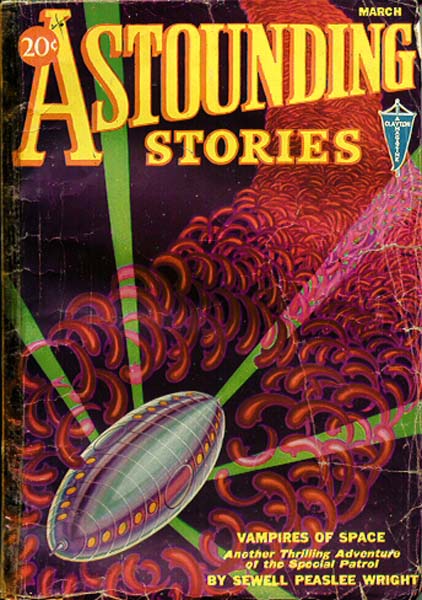 You thought comic book covers could be loaded with sexual imagery? Check out the Space-Vagina cover of the March 1932 Astounding Stories pulp magazine.
You thought comic book covers could be loaded with sexual imagery? Check out the Space-Vagina cover of the March 1932 Astounding Stories pulp magazine.
At least comic book art hides it a bit with a costume seam or something. The artist for this cover appears to have taken inspiration right out of a textbook on female biology.
That's 1932, folks! Marketing has not changed a bit.
Tags: Seduction of the Innocent Pulp
Posted by
Sleestak
at
3/20/2006 07:28:00 AM
2
comments
![]()
![]()
Saturday, March 18, 2006
For Queen and Country, James?
Megalomaniac-smashing is a stressful job so I guess one can't be too surprised when Ian Fleming's super-spy James Bond takes a break from saving the world to relieve some tension. I'm not at all shocked that DC would be so graphic in depicting the private moments of Mr. Bond because the Silver Age DC was all about smuggling things in under the radar of the Comics Code Authority.
I can imagine the horrifying slash fiction that this panel will inevitably inspire:
GOLDFINGERED
"Alright, Goldfinger. You expect me to talk?"
"No, Mr. Bond. I expect you to masturbate."
Posted by
Sleestak
at
3/18/2006 04:21:00 AM
3
comments
![]()
![]()
Friday, March 10, 2006
Songs anyone can sing good
This is probably my last post until next Tuesday. I'm moving to a new place today and in the fast-paced, cutting edge, digital world of today it takes 5 days to transfer my service to the new apartment. The future is now!
So to hold you all over here is a short list of songs that even the most tone-deaf, inept performer can sing and sound good. Try it! You'll see, even sounds great acapella.
Scotch and Soda - Kingston Trio
Big Yellow Taxi - Counting Crows
Tequila Sunrise - Eagles
Everybody's Talkin' - Henry Nilson
Posted by
Sleestak
at
3/10/2006 04:18:00 AM
3
comments
![]()
![]()
Tuesday, March 07, 2006
Comic Book Ad: Tongue Game
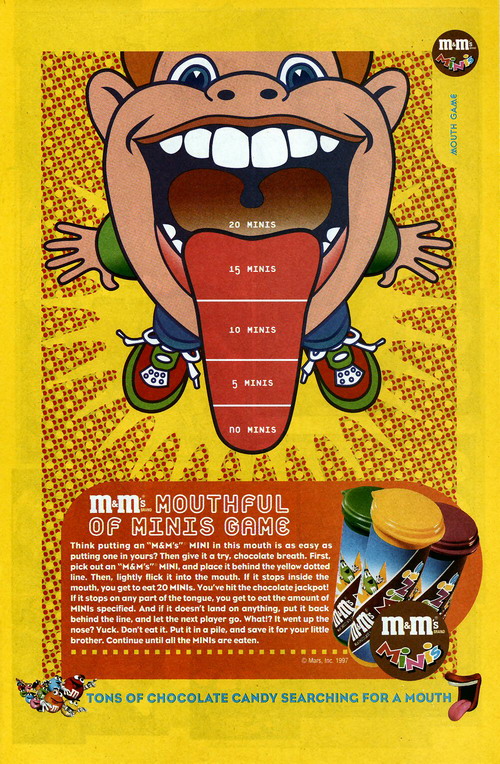 Unsettling, even one could say subliminally loaded, advertisement originally published in Marvel's Star Trek: Early Voyages #7 (August 1997).
Unsettling, even one could say subliminally loaded, advertisement originally published in Marvel's Star Trek: Early Voyages #7 (August 1997).
Posted by
Sleestak
at
3/07/2006 11:00:00 AM
1 comments
![]()
![]()
Sunday, March 05, 2006
Oscar Live Blogging: Maymors Uffa Gaysha
 I'm not going to comment on the entire Oscar telecast like other bloggers. As Ted Sturgeon says, "90 per cent of everything is crap." I agree, so I am only going to cover the percentage of the 78th Academy Awards telecast that actually matters: The Part With Salma Hayek.
I'm not going to comment on the entire Oscar telecast like other bloggers. As Ted Sturgeon says, "90 per cent of everything is crap." I agree, so I am only going to cover the percentage of the 78th Academy Awards telecast that actually matters: The Part With Salma Hayek.
Salma Hayek is now presenting the nominees for best Music Score. She should have been hired to be the host and also do the job of all the presenters. This would have been a much better show if the Academy had the wisdom to sign her up.
Wow. I mean, wow.
Yes, Salma...flip that hair again like you do.
"Maymors Uffa Gaysha" She says. Love that accent. Who won? Who cares! Keep talking, Salma.
And that's it. Darn. Three minutes with Salma is not enough. Well, time to change the channel to Sci Fi or something.
Salma Hayek really makes me appreciate being a guy.
Posted by
Sleestak
at
3/05/2006 06:30:00 PM
3
comments
![]()
![]()
Labels: oscars, salma hayek
My Favorite Screensaver & High-Rise Security
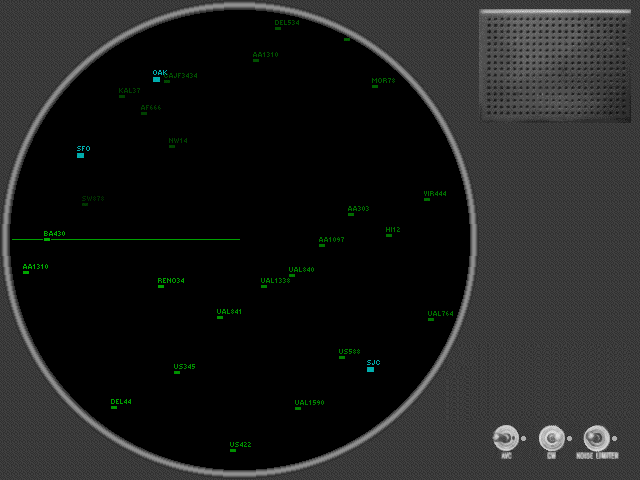 Here is a screenshot of the old, popular Air Traffic Control screensaver. Way back when in the mid-1990's I installed it on a publicly-viewable computer monitor at a security guard station in San Diego. In this particular building the security desk was positioned in such a way that all the dry-erase boards, paperwork, closed-circuit security camera monitors and computers could be seen and eavesdropped on by the general public from a large window.
Here is a screenshot of the old, popular Air Traffic Control screensaver. Way back when in the mid-1990's I installed it on a publicly-viewable computer monitor at a security guard station in San Diego. In this particular building the security desk was positioned in such a way that all the dry-erase boards, paperwork, closed-circuit security camera monitors and computers could be seen and eavesdropped on by the general public from a large window.
As the then Director of Security for a major high-rise, that lack of common sense in security procedure made me crazy (1). Let's face it, to use a sports analogy for the first and last time in my life, you don't hand the other team a copy of your playbook before the big game! In the military, they call that 'EEFI', which stands for Essential Elements of Friendly Information. In every war the Armed Services usually learns a few hard lessons about EEFI. During the Vietnam conflict it was a common practice to post the duty rosters in public, to be viewed by anyone, including the enemy. The unfriendlies used the info to determine troop positions and strengths for any given day. One Cold War anecdote about communist Russia comes to mind, in that an allied government became aware that a substantial increase in mitten purchases could have meant a winter build-up of armed forces on some friendly borders, so the other side responded in a way to block the build-up. It's also why military communications, both personal and otherwise are subject to monitoring and censorship. A large requisition of tire patch kits moving to Wisconsin may not mean much to the average person but there are entire agencies devoted to putting all the little bits of info together and using it all to gain an advantage over the other guys.
At the building where I worked I was concerned by the numbers of passers-by, homeless and thieves casing the area by watching what security was doing on our monitors. From outside the building standing on public property the ring-leader could watch through a window and see where our elevators were, where the guards were heading, how we were responding and etc. FYI, the leaders were usually over 18 and therefore legal adults and the other members of the raiding parties were usually juveniles, dealing with whom changed the playing field somewhat, as they were well aware. They were all pretty bold, standing outside on the sidewalk and using cell phones to communicate with their partners who were on the property evading security. It was maddening.
While altering methods in how we operated took care of most of the semi- and professional low-lifes, a few simple changes blocked the amateurs. Dry-erase boards were removed, a n obscuring screen-filter was put on the elevator control monitor among other changes. One of the most successful ways of defeating the bad guys was to have the person on the desk remain calm (2). When a young guard behaves with drama or panics, it clues others in that something is happening or fosters more panic.
On the PC at the security desk I installed the Air Traffic Control screensaver and tweaked the settings so it would activate after a minute of PC idle time, hiding any available info and serving as a ruse of technology that we did not possess.
The homeless guys were often a bit addled, either through chemicals or the stresses of living on the street, so they were easy to manipulate. When they nonchalantly sidled on up to the street-side window to look at the CCTV screens I'd point to them, then point to a glowing dot on the screensaver, then point to them again. They were led to believe that they were being tracked by sensors so we would know where they were and what they were up to. Soon, the homeless quit hanging around once they got the message. A simple deception but one that worked well enough (when combined with other changes) on the targeted demographic.
(1) Security often seems to be an afterthought in many buildings or as an annoyance and necessary evil. One place I worked allowed business cards to be used as personal identification or entry passes (a note on the back saying 'Please let so-and-so into my office tonight. Thanks, Bob'), allowing security guards to let people into locked offices after normal business hours. Of course, the criminal network (this info was usually spread by an employee wanting cash to some buddy of thiers) knows what businesses allow this and runners spend the day gathering cards, using them to gain entry at night and steal laptops and sandwiches from the community fridges.
(2) It would go something like this: A fire alarm would activate on the 31st floor and the guard would panic a bit. I'd ask, "Are you on fire?" The guard would pause and reply he wasn't, the alarm was 30 floors away from his position in the lobby. I'd then say, "You are 5 feet from the main lobby doors. When it gets hot you can just step outside. Until then use the Quick Response Checklist, help the Fire Department when they arrive to check the alarm and do the job."
Fear is the mind-killer.
Posted by
Sleestak
at
3/05/2006 06:57:00 AM
3
comments
![]()
![]()
Saturday, March 04, 2006
Grocery Store Artifact: Nicholas Cage
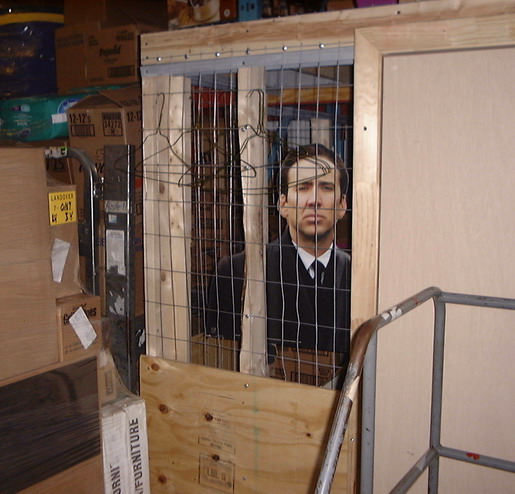 This "plug" of Nicholas Cage was originally from the cardboard DVD display placed in the store where I work for the recent release of the snoozer, The Lord of War. For reasoning I can only evaluate as insane, some wit in a marketing department decided that a life-sized head shot cutout of Cage being creepy would help sell copies of the DVD (it didn't). After a few weeks enough of the DVDs were sold/shoplifted that the stand looked empty-ish and too esthetically displeasing to keep on the sales floor so it was tossed out. The DVD's were moved to the regular movie section of the store (a bin of loose, variably-priced films in the Seasonal aisle).
This "plug" of Nicholas Cage was originally from the cardboard DVD display placed in the store where I work for the recent release of the snoozer, The Lord of War. For reasoning I can only evaluate as insane, some wit in a marketing department decided that a life-sized head shot cutout of Cage being creepy would help sell copies of the DVD (it didn't). After a few weeks enough of the DVDs were sold/shoplifted that the stand looked empty-ish and too esthetically displeasing to keep on the sales floor so it was tossed out. The DVD's were moved to the regular movie section of the store (a bin of loose, variably-priced films in the Seasonal aisle).
Before the stand was compacted and baled someone rescued the cut out of Nepotism Nicky and put it in one of the locked storage cages in the warehouse. Every time I walk by it I get a little start when I catch the creepy bastard's profile out of the corner of my eye. It freaks me out. I know it's there, but it still surprises me a bit every time I go down the corridor because I'm not expecting to see anyone peering out of a storage cage.
I just know that one day I'm going to be walking down that corridor and someone clever will actually be in the storage area getting something when I pass by and will take the opportunity to yell 'Boo!' and make me crap my pants.
Posted by
Sleestak
at
3/04/2006 06:30:00 PM
2
comments
![]()
![]()
Labels: Grocery Store Artifact, trashvertising
Thursday, March 02, 2006
Star Trek's racism
Star Trek is racist. I don't want to hear about TV's first interracial kiss being on Star Trek (it was forced). I don't buy the multi-ethnic cast either because it's obvious from watching the show and reading the "official" books that Federation is all about keeping those other funny-looking races and species in their place and under the control of "The Man".
Check out this scene from Star Trek: Early Voyages #15 (Apr 1998). This Marvel Comics series ran some hit-or-miss stories of the crew early in the history of the Enterprise as it was under the command of Captain Christopher Pike*. When a biological agent infects the Enterprise the Doctor is unable to stop the virus from eating the ship's circuitry, so he lets a young Spock give it a try.
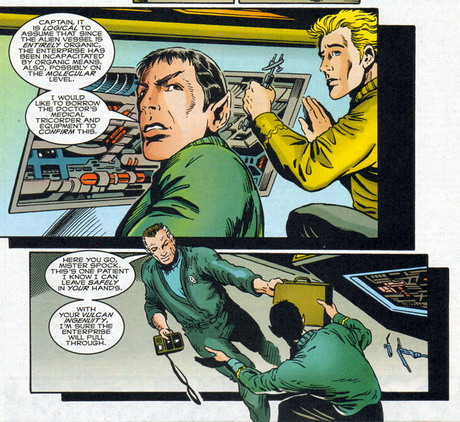
"With your Vulcan ingenuity, I'm sure the Enterprise will pull through."Well, that's just downright condescending and blatant, institutionalized racism. The Doc is marginalizing the person and his skills. He makes it clear that if Li'l Spocky manages to fix the ship when he failed then it is not because Spock is smart and capable, it is due to his genes. That's the same as saying a particular ethnic group is good at sports or fixing cars because of their race. That's crap. I think the Doc is lucky that Spock represses his rage and saves it up for release during the Vulcan equivalent of prom night, the ritual Spa Fon (or whatever it's called).
Imagine if the Doctor was addressing someone else like that other than Spock. Like say...
Geordi:
"With your African-American ingenuity, I'm sure the Enterprise will pull through."
That Stupid-Looking Ensign behind Spock:
"With your Caucasian ingenuity, I'm sure the Enterprise will pull through."
Sulu:
"With your Asian ingenuity, I'm sure the Enterprise will pull through."
Christian Slater:
"With your crappy, awkward cameo ingenuity, I'm sure the Enterprise will pull through."
The Menagerie's Majel Barrett as Number 1:
"With your woman's ingenuity, I'm sure the Enterprise will pull through."
Dr. Stephen Hawking:
"With your diseased ingenuity, I'm sure the Enterprise will pull through. You brave little soldier. You're so brave!"
Jared:
"With your former fat-ass veggie-sandwich-eating ingenuity, I'm sure the Enterprise will pull through."
Hayley Mills:
"With your incredible hotness, I'm sure the....MARRY ME, HAYLEY!"
* I don't know what the show was that aired in place of a series based on The Menagerie. You know, the one we are all familiar with that ran for years in syndication, spawning franchises on TV and film both good and bad, but it sure wasn't Star Trek. As far as I'm concerned, there is no Star Trek after The Menagerie. Just some diluted imitation.
Posted by
Sleestak
at
3/02/2006 06:25:00 PM
9
comments
![]()
![]()

